Entdecke die besten Vietnam-Reisetipps von lokalen Experten, um deine Reise unvergesslich zu machen. Von wichtigen Tipps zur Reiseplanung bis hin zu Insider-Empfehlungen für das Eintauchen in die lebendige Kultur des Landes – hier findest du alles, was du für eine reibungslose und unvergessliche Vietnam-Reise brauchst.
Das sind die absolut besten Vietnam-Reisetipps, die du finden kannst. Wir haben sie in drei Hauptkategorien unterteilt, um dir die Reiseplanung zu erleichtern:
- Reisetipps zur Planung deiner Vietnam-Reise: Diese Tipps decken die wichtigsten Schritte ab, wie du die richtigen Reiseziele auswählst, Flüge buchst und Unterkünfte findest, die zu deinem Stil und Budget passen.
- Vietnam-Reisetipps: Was du vor der Reise vorbereiten solltest: In diesem Abschnitt erfährst du, wie du dich optimal auf deine Reise vorbereitest – vom Visum über die richtige Packliste bis hin zu wichtigen Dingen, die du für eine stressfreie Reise mitnehmen solltest.
- Reisetipps während deiner Vietnam-Reise: Sobald du in Vietnam angekommen bist, helfen dir diese Tipps, dich im Alltag zurechtzufinden – mit Infos zu kulturellen Gepflogenheiten, Transportmöglichkeiten und wichtigen Sicherheitshinweisen für unterwegs.
Tipp: Lade unser kostenloses eBook herunter
Bevor wir mit den Tipps starten, empfehlen wir dir, unser kostenloses eBook herunterzuladen. Der Guide enthält über 200 Seiten mit unverzichtbaren Reisetipps – von detaillierten Reiseziel-Beschreibungen über Transporthinweise bis hin zu kulturellen Einblicken und Muster-Reiseplänen für verschiedene Reisedauern. Das Beste daran? Es ist völlig kostenlos und erleichtert dir die Reiseplanung enorm.
Reisetipps zur Planung deiner Vietnam-Reise
Die Planung einer Reise nach Vietnam kann überwältigend sein, da es so viele unglaubliche Orte zu entdecken und Dinge zu erleben gibt. Diese Tipps helfen dir, deine Reiseroute effizient zu planen, Inspiration für Reiseziele zu finden und Flüge sowie Unterkünfte problemlos zu buchen.
1. Versuche nicht, alles zu sehen
2. Beste Reisezeit für Vietnam
3. Die besten Aktivitäten in Vietnam je nach Interesse
4. Start in Ho Chi Minh Stadt oder Hanoi?
5. Buche deine Flüge nach Vietnam
6. Buche deine Unterkünfte
7. Fortbewegung in Vietnam: Buchung von Inlandsflügen, Zügen und Bussen
1. Versuche nicht, alles zu sehen
Vietnam ist voller atemberaubender Orte, aber zu viele davon in eine Reise zu packen, kann schnell stressig und anstrengend werden. Die Reisezeiten sind oft länger als erwartet, besonders wegen der kurvigen Bergstraßen und langsamen Züge. Zum Beispiel kann eine 100 km lange Fahrt im Norden Vietnams mehr als 3 Stunden dauern, und Zugfahrten sind häufig deutlich langsamer als in Europa.
Viele Reisende verbringen am Ende mehr Zeit unterwegs als mit dem eigentlichen Erkunden. Konzentriere dich stattdessen auf ein paar ausgewählte Reiseziele, um deine Zeit wirklich zu genießen. Hier ist eine Orientierung, wie du deine Reise je nach verfügbarer Zeit gestalten kannst:
- 1 Woche: Bleib in einer Region, zum Beispiel in Hanoi, der Halong Bucht und Sapa im Norden.
- 2 Wochen: Erkunde eine oder zwei Regionen, wie den Norden und Zentralvietnam.
- 3 Wochen: Kombiniere zwei oder drei Regionen für ein umfassenderes Erlebnis.
- 4 Wochen: Entdecke den Norden, die Mitte und den Süden Vietnams in einem entspannten Tempo.
2. Beste Reisezeit für Vietnam
Vietnams Wetter variiert stark von Nord nach Süd, daher hängt die beste Reisezeit davon ab, welche Regionen du erkunden möchtest. Ein Verständnis des lokalen Klimas hilft dir, das Beste aus deiner Reise herauszuholen.
- Nordvietnam: Die beste Reisezeit ist von Oktober bis April, wenn das Wetter kühler und angenehmer ist. Der Sommer (Mai bis August) ist jedoch ideal, wenn du die Reisfelder in voller Blüte sehen möchtest.
- Zentralvietnam: Von Februar bis August herrschen hier die besten Bedingungen – trockenes, sonniges Wetter, perfekt für Strandtage und Besichtigungen.
- Südvietnam: Die Monate November bis April sind optimal für trockenes, sonniges Wetter, während die Regenzeit von Mai bis Oktober dauert.
Insgesamt sind die Monate Februar bis April die beste Zeit für eine Reise durch das gesamte Land, da das Wetter in ganz Vietnam dann ausgeglichen und angenehm ist.
Lies hier unseren vollständigen Guide über: beste Reisezeit für Vietnam.
3. Die besten Aktivitäten in Vietnam je nach Interesse
Vietnam bietet für jeden Reisetyp etwas. Egal, ob dich Geschichte, Natur oder Abenteuer reizen – es gibt unzählige Erlebnisse, die auf dich warten. Die richtige Auswahl zu treffen, kann jedoch schwierig sein, da jeder Reisestil und jedes Interesse unterschiedlich sind. Um dir bei der Planung zu helfen, haben wir einige Empfehlungen basierend auf beliebten Interessen zusammengestellt:
- Top-Sehenswürdigkeiten in Vietnam: Von antiken Tempeln über lebendige Städte bis hin zu majestätischen Palästen und ruhigen Nationalparks – Vietnams Sehenswürdigkeiten sind ebenso vielfältig wie atemberaubend. Erfahre mehr in unserem Guide zu den besten Sehenswürdigkeiten in Vietnam.
- Kulturelle Erlebnisse: Entdecke die reiche Geschichte und Tradition Vietnams durch seine Tempel, Feste und lokalen Märkte. Für mehr kulturelle Inspiration sieh dir unsere erstaunlichen kulturellen Erlebnisse in Vietnam an.
- Kulinarische Erlebnisse: Vietnams Esskultur ist legendär und reicht von Street food bis hin zu Gourmetgerichten. Erfahre mehr in unserem Guide zu den besten kulinarischen Erlebnissen in Vietnam.
- Strände: Wenn du Entspannung am Meer suchst, findest du in Vietnam einige der schönsten Strände Südostasiens. Sieh dir unsere Liste der schönsten Strände an, um deinen perfekten Strandurlaub zu planen.
- Reisfelder: Die ikonischen Reisterrassen Vietnams bieten einige der beeindruckendsten Ausblicke des Landes. Entdecke die schönsten Reisfelder und die besten Orte für einen Besuch.
- Abenteuer: Für Adrenalin Junkies bietet Vietnam endlose Abenteuer – von Wandern bis Kajakfahren. Tauche ein in die coolsten Abenteueraktivitäten, um deine Reise unvergesslich zu machen.
- Trekking: Ob in den Hochländern oder durch üppige Täler – Trekking in Vietnam ist ein Muss. Finde die besten Trekking-Destinationen für dein Abenteuer.
- Natur: Wenn du nach atemberaubenden Landschaften suchst, bietet Vietnam einige der beeindruckendsten Naturschauplätze der Welt. Entdecke die schönsten Naturziele, um deine naturreiche Reise zu planen.
Jeder dieser Links führt zu detaillierten Artikeln, die dir helfen, die besten Erlebnisse entsprechend deinen Interessen zu planen.

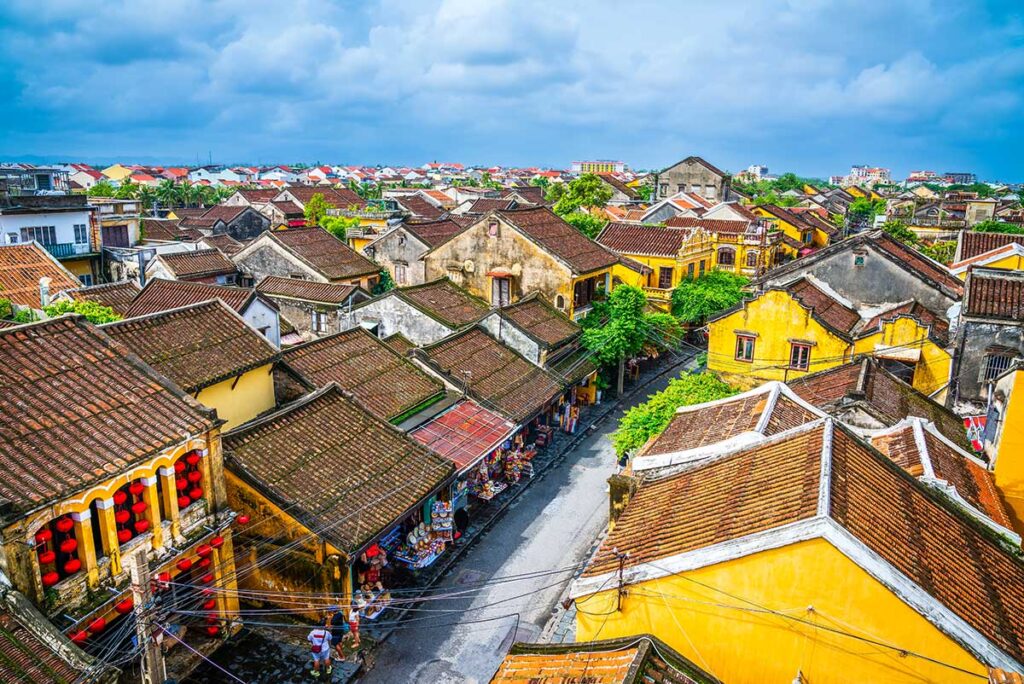
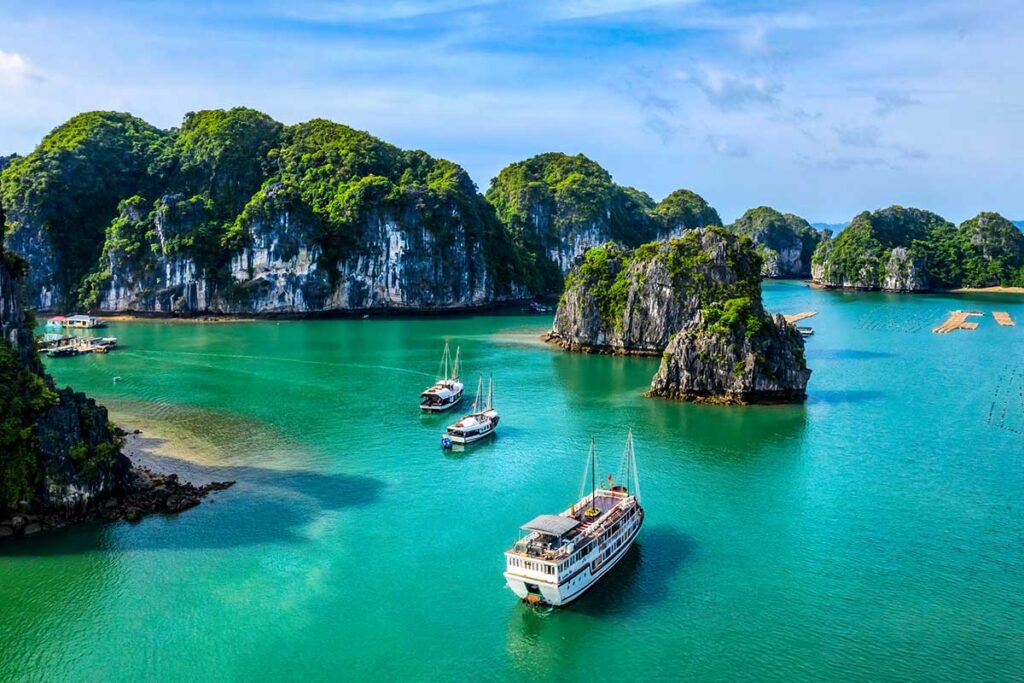
4. Start in Ho Chi Minh Stadt oder Hanoi?
Ob du deine Reise in Ho Chi Minh Stadt (HCMC) oder Hanoi beginnst, hängt von deinem Reiseplan, deinen Vorlieben und den verfügbaren Flügen ab. Beide Städte bieten einzigartige Erlebnisse und Zugang zu verschiedenen Regionen des Landes.
Flugkosten und Multistop-Tickets: Überprüfe Multistop-Tickets (z. B. Hinflug nach Hanoi und Rückflug ab Ho Chi Minh Stadt) und vergleiche die Kosten, um die günstigste Option zu finden.
Warum in Ho Chi Minh Stadt starten:
Wenn du dich auf Südvietnam konzentrierst, ist ein Start in HCMC eine gute Wahl. Die Stadt hat mehr internationale Flugverbindungen, was die Anreise einfacher und oft günstiger macht. Zudem ist sie westlicher geprägt, was den Einstieg für viele Reisende erleichtert. Ein Start im Süden ermöglicht es dir, Richtung Norden zu reisen – ideal, da die Landschaft auf dem Weg nach oben immer beeindruckender wird.
Warum in Hanoi starten:
Hanoi bietet eine Fülle an Sehenswürdigkeiten und Erlebnissen, von antiken Tempeln und lokalen Märkten bis hin zu lebhaftem Straßenleben. Es ist der perfekte Ausgangspunkt für alle, die Nordvietnam erkunden wollen. Mit der Nähe zu Reisezielen wie Sapa, Halong Bucht und Ninh Binh gibt es hier viel zu entdecken. Der Charme der Stadt liegt in der Mischung aus Moderne und Tradition, was dir einen immersiven Einblick in die vietnamesische Kultur bietet.
Geheimtipp: Wenn du mit Local Vietnam buchst, empfehlen wir, in Hanoi zu starten, da unser Expertenteam dort ansässig ist und dir ab deiner Ankunft persönliche Empfehlungen geben kann.
5. Buche deine Flüge nach Vietnam
Beim Buchen deines Fluges nach Vietnam kannst du durch gute Planung Zeit und Geld sparen. Vietnams Flugnetz ist gut ausgebaut, aber da es kein zentrales Drehkreuz gibt, beinhalten Flüge oft einen Zwischenstopp. Hier sind einige Tipps, um den Buchungsprozess zu erleichtern:
Vermeide lange Zwischenstopps
Lange Aufenthalte können deine Reise unnötig erschweren. Versuche, Flüge mit kurzen Transitzeiten zu buchen, um mehr Zeit zur Erholung und weniger Wartezeit an Flughäfen zu haben.
Buche im Voraus
Um die besten Preise zu sichern, solltest du deinen Flug frühzeitig buchen. In der Hochsaison am besten mindestens 3 Monate im Voraus, in der Nebensaison reicht oft eine kürzere Vorlaufzeit. Je früher du buchst, desto besser sind deine Chancen auf günstige Angebote.
Nutze Flugvergleichsseiten
Vergleiche Flüge auf Plattformen wie Skyscanner, Google Flights oder momondo. Diese Seiten zeigen dir verschiedene Airlines, Preise und Routen, damit du das beste Angebot findest.
Richte Preisalarme ein
Wenn du bei den Reisedaten flexibel bist, erstelle Preisalarme auf Skyscanner oder ähnlichen Seiten. So wirst du benachrichtigt, wenn die Preise fallen, und kannst zum günstigsten Zeitpunkt buchen.
Fliege unter der Woche
Flüge sind in der Regel an Wochentagen, besonders dienstags und mittwochs, günstiger. Wenn möglich, buche deine Flüge für diese Tage, um die höheren Wochenendpreise zu vermeiden.
6. Buche deine Unterkunft
Die Wahl der richtigen Unterkunft in Vietnam kann dein Reiseerlebnis erheblich verbessern. Ob Luxusresort, günstiges Hostel oder authentisches Homestay – hier sind Tipps, um die beste Wahl zu treffen:
Lage ist entscheidend
Achte beim Buchen nicht nur auf den Preis, sondern auch auf die Lage. In zentralen Stadtteilen wie Hanois Altstadt oder dem District 1 in Ho Chi Minh Stadt bist du nah an Sehenswürdigkeiten, Restaurants und Verkehrsanbindungen. In ländlichen Gebieten wie Sapa oder Ninh Binh bieten Unterkünfte auf dem Land eine ruhigere Atmosphäre und bessere Aussichten.
Achte auf Zimmer ohne Fenster
In großen Städten haben manche Hotels aufgrund der engen Bebauung Zimmer ohne Fenster. Überprüfe die Zimmerbeschreibung und Bewertungen, um sicherzustellen, dass du bekommst, was du erwartest.
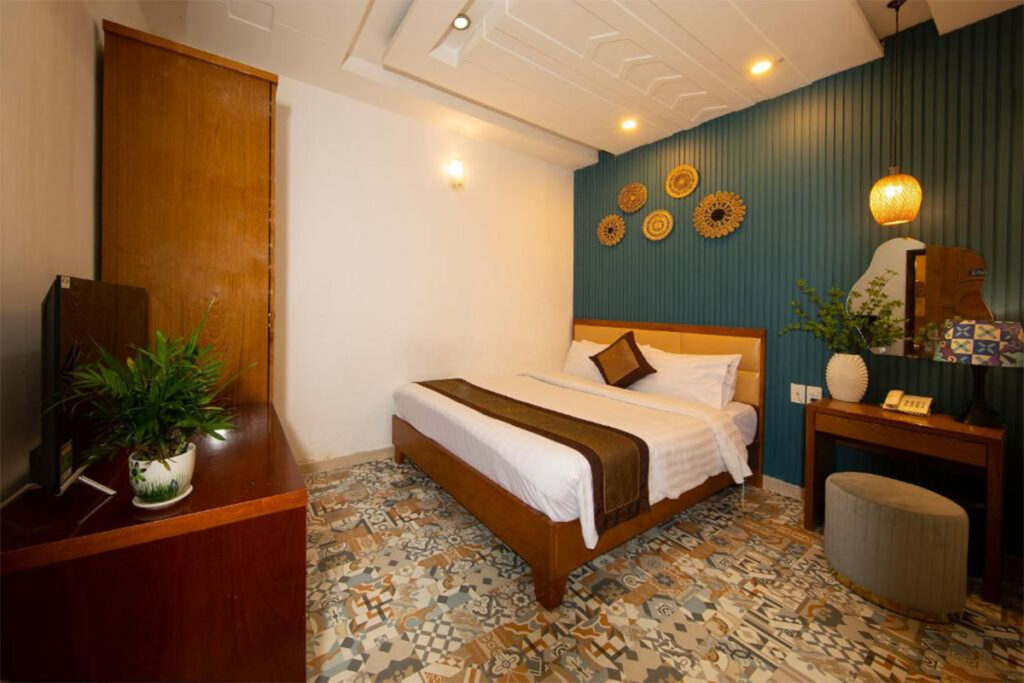
Übernachte in ethnischen Homestays für ein authentisches Erlebnis
Für eine authentische Erfahrung solltest du in ethnischen Homestays übernachten, besonders in Regionen wie Sapa oder Ha Giang. Diese Unterkünfte sind einfach, bieten aber tiefe Einblicke in das lokale Leben, inklusive gemeinsamer Mahlzeiten und kultureller Erlebnisse. Viele dieser Homestays sind nicht online zu finden, daher empfiehlt es sich, einen lokalen Reiseanbieter oder Guide zu fragen.
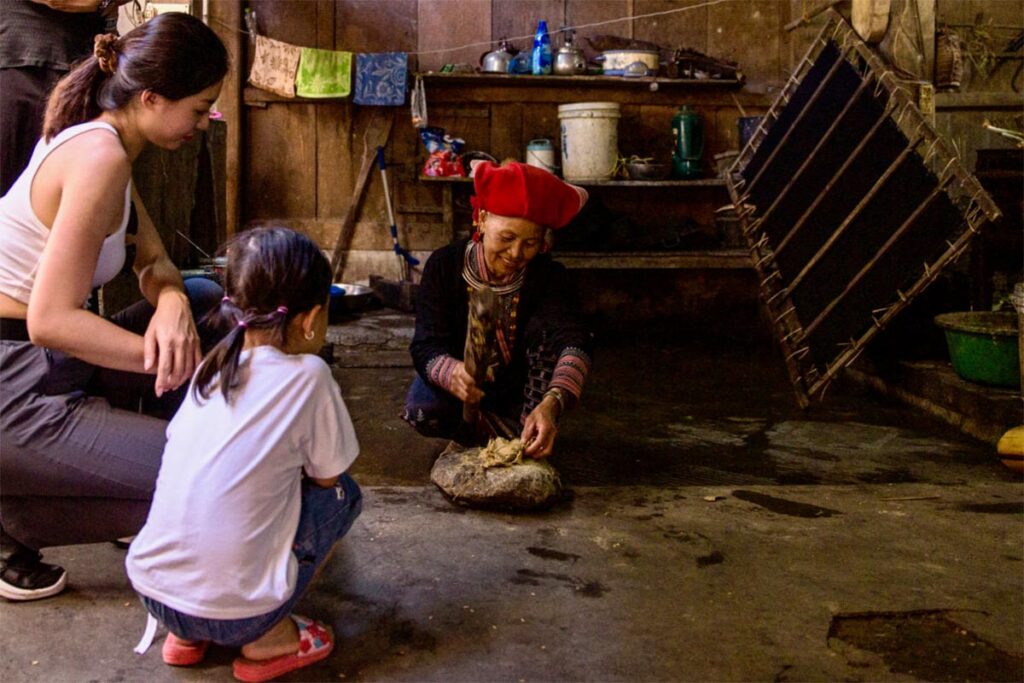
Buche frühzeitig in der Hochsaison
Vietnam ist besonders während der Hauptreisezeiten wie Tet (vietnamesisches Neujahr) und den Sommermonaten beliebt. In diesen Zeiten solltest du deine Unterkunft rechtzeitig buchen, um Enttäuschungen und hohe Preise zu vermeiden.
7. Fortbewegung in Vietnam: Flüge, Züge und Busse buchen
Vietnam bietet eine Vielzahl an Transportmöglichkeiten, um das Land zu erkunden. Ob zwischen Städten oder in ländlichen Gebieten – hier erfährst du, was du über die verschiedenen Transportmittel wissen musst:
Inlandsflüge
Vietnam verfügt über ein gut ausgebautes Netz an Inlandsflügen zwischen Städten wie Hanoi, Ho Chi Minh Stadt, Da Nang und Nha Trang. Flüge sind günstig und beginnen oft schon ab 35 €. Vietnam Airlines gilt als zuverlässig, während VietJet Air oft die besten Preise bietet, aber auch für Verspätungen bekannt ist.
Geheimtipp: Buche frühzeitig für die besten Preise und nutze Plattformen wie Traveloka zur Buchung.
Busse
Busse sind die günstigste Möglichkeit, in Vietnam zu reisen, auch in abgelegene Regionen. Die Qualität variiert jedoch, besonders bei Nachtbussen. Für eine bequemere und sicherere Fahrt solltest du einen Limousinen-Van buchen, der tagsüber verkehrt und mehr Komfort bietet.
Geheimtipp: Buche Busse über Vexere und lies dir die Bewertungen sorgfältig durch, um einen zuverlässigen Anbieter zu finden.
Zugreisen
Züge bieten eine landschaftlich reizvolle und oft günstigere Alternative zum Fliegen, sind jedoch langsamer. Das Zugnetz verläuft hauptsächlich entlang der Küste und verbindet Städte wie Hanoi, Da Nang und Ho Chi Minh Stadt. Für mehr Komfort bei Nachtfahrten solltest du eine 4-Bett-Schlafkabine buchen.
Geheimtipp: Buche Züge über 12go.asia oder Baolau.
Bonustipp: Reise nachts, um Zeit zu sparen
Nachtbusse sind die günstigste Option, aber nicht immer die bequemste oder sicherste. Nachtzüge bieten eine sichere und komfortable Alternative für Übernachtfahrten.
Vietnam Reisetipps: Was du vor der Abreise vorbereiten solltest
Eine gute Planung und Vorbereitung sind der Schlüssel zu einer reibungslosen und angenehmen Vietnam-Reise. Hier sind wichtige Tipps, was du vor deiner Abreise vorbereiten solltest:
8. Beantrage dein E-Visum so früh wie möglich
9. Lade diese Apps herunter
10. Rucksack oder Koffer?
11. Welche Kleidung du mitbringen solltest
12. Gesundheitstipps für Reisen in Vietnam
13. Reiseadapter mitbringen
14. Schließe eine Reiseversicherung ab
8. Beantrage dein E-Visum so früh wie möglich
Reisende aus Deutschland
Reisende aus Deutschland können bis zu 45 Tage visumfrei nach Vietnam einreisen, daher ist für kurze Aufenthalte kein E-Visum erforderlich. Wenn du planst, länger als 45 Tage zu bleiben, musst du jedoch ein E-Visum beantragen.
Reisende aus Österreich und der Schweiz
Für Reisende aus Österreich und der Schweiz ist ein E-Visum für jeden Aufenthalt in Vietnam verpflichtend. Dieses kann einfach online über die offizielle Website der vietnamesischen Einwanderungsbehörde beantragt werden. Ein Besuch bei der Botschaft oder die Nutzung eines Agenten ist nicht notwendig – der Prozess ist schnell und unkompliziert.
So beantragst du ein E-Visum
Der Antrag für ein E-Visum ist einfach. Du kannst direkt über die offizielle Website der vietnamesischen Einwanderungsbehörde einen Antrag stellen. Die Bearbeitungszeit beträgt in der Regel 3 bis 5 Werktage. Falls du einen Fehler in deinem Antrag machst, kannst du ihn kostenlos korrigieren, allerdings verlängert sich die Bearbeitungszeit dann um weitere 3 bis 5 Tage. Um Verzögerungen zu vermeiden, solltest du deinen Antrag frühzeitig stellen.
Reisetipp: Damit alles reibungslos verläuft, folge einfach unserem Schritt-für-Schritt-Guide zur Beantragung eines Vietnam-E-Visums.
9. Lade diese Apps herunter
Die richtigen Apps auf deinem Handy machen deine Reise nach Vietnam deutlich einfacher und angenehmer. Ob zur Navigation in der Stadt oder zum Finden der besten Restaurants – diese Apps helfen dir, immer gut vernetzt zu sein und das Beste aus deiner Zeit im Land zu machen.
Grab
Grab ist die beliebteste Ride-Hailing-App in Vietnam. Sie funktioniert ähnlich wie Uber und ermöglicht es dir, Taxis, Motorradtaxis oder sogar Essenslieferungen einfach zu buchen. Besonders in Städten wie Hanoi und Ho Chi Minh Stadt ist Grab unverzichtbar.
TripAdvisor
TripAdvisor ist eine großartige App für Restaurantempfehlungen, Hotelbewertungen und Aktivitäten. Mit echten Bewertungen anderer Reisender kannst du fundierte Entscheidungen treffen und die besten Orte zum Essen, Übernachten und Besuchen finden.
XE Currency Converter
XE Currency ist eine unverzichtbare App, um vietnamesische Dong schnell in deine Heimatwährung umzurechnen. Besonders hilfreich beim Budgetieren und beim Einkaufen, um sicherzustellen, dass du faire Preise zahlst.
Google Maps
Google Maps ist ein Muss für die Navigation in unbekannten Gegenden. Lade dir Offline-Karten vor deiner Reise herunter, um dich auch ohne Internetzugang zurechtzufinden. Perfekt, um Restaurants zu finden, Sehenswürdigkeiten zu erkunden und dich nicht zu verlaufen.
Google Translate
Google Translate ist ein Lebensretter bei Sprachbarrieren. Lade die Sprachpakete für den Offline-Gebrauch herunter, und du kannst jederzeit schnell übersetzen – ideal für die Kommunikation unterwegs.
Für eine detaillierte Liste hilfreicher Apps für deine Vietnam-Reise, sieh dir unsere 23 unverzichtbaren Reise-Apps an, die deine Reise noch einfacher machen.
10. Rucksack oder Koffer?
Ob du mit einem Rucksack oder einem Koffer reist, hängt stark von deinem Reisestil und der Art deiner Reise ab. Beide Optionen haben ihre Vor- und Nachteile, daher hier einige Überlegungen, bevor du dich entscheidest.
Rucksack
Ein Rucksack ist ideal, wenn du günstig reisen oder abgelegenere Gebiete besuchen möchtest. Vietnams Gehwege können uneben sein, und Städte wie Hanoi und Ho Chi Minh Stadt sind oft überfüllt – da ist ein Rucksack praktischer als ein Koffer. Außerdem bist du mit einem Rucksack flexibler, besonders wenn du viel mit Bussen, Zügen und anderen Verkehrsmitteln unterwegs bist.
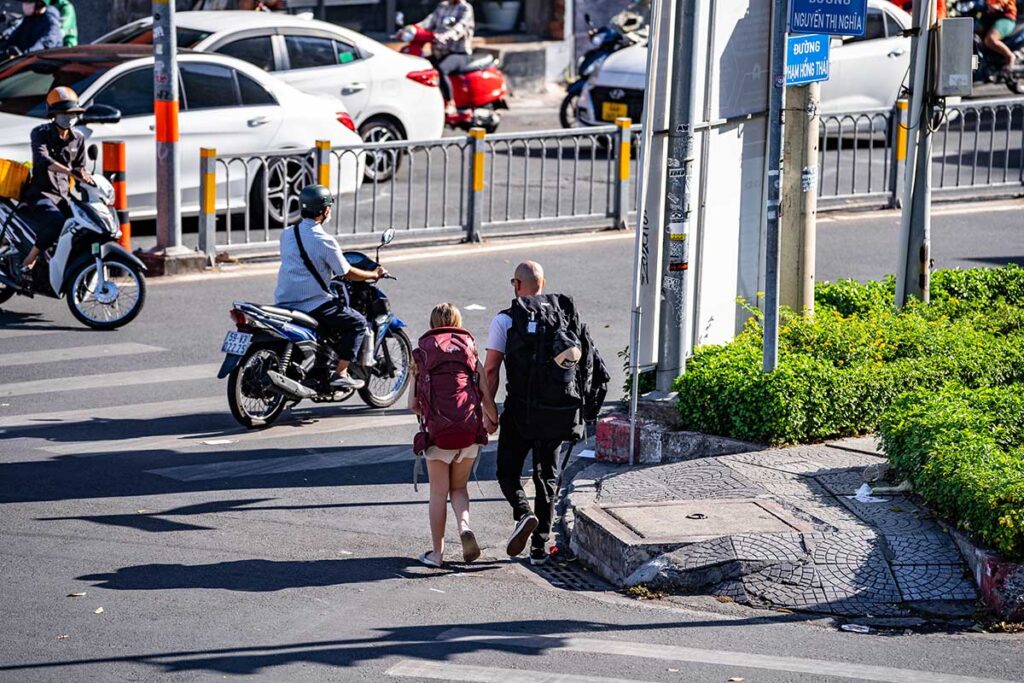
Koffer
Wenn du mit mehr Komfort reist oder kein knappes Budget hast, ist ein Koffer in Vietnam absolut machbar. Mit Taxis, privaten Transfers und vielen Fernbussen, die bequeme Abhol- und Bringdienste bieten, ist das Reisen mit einem Koffer kein Problem. Viele Reisende entscheiden sich jedoch dafür, leicht zu packen, um nicht zu viel zu schleppen – daher gilt: Ein Koffer ist möglich, aber packe so leicht wie möglich, um den Komfort beim Reisen zu gewährleisten.
11. Welche Kleidung solltest du mitbringen?
Der beste Packtipp für Vietnam: Packe nicht zu viel ein. Leichte, atmungsaktive Kleidung ist ein Muss, aber weniger ist mehr. Vietnams Klima variiert je nach Region, und cleveres Packen hilft dir, dich wohlzufühlen, ohne zu überladen zu sein.
Leichte, atmungsaktive Kleidung
Vietnam hat ein tropisches Klima, daher sind leichte und atmungsaktive Stoffe wie Baumwolle oder Leinen ideal – besonders im heißen und feuchten Süden. Für den Norden solltest du im Winter auch eine leichte Jacke oder einen Pullover einpacken, da es dort kühler werden kann.
Schichtkleidung
Da das Wetter in Vietnam stark variieren kann, ist das Tragen von Schichten eine kluge Wahl. Packe Kleidung, die du leicht anpassen kannst – ob in den kühlen Bergen oder im tropischen Süden. Eine leichte Jacke oder ein Regenmantel sind in der Regenzeit (Mai bis Oktober) ebenfalls nützlich, da plötzliche Regenschauer häufig sind.
Bequeme Schuhe
Ein wichtiger Tipp für die Erkundung Vietnams: Trage bequeme Schuhe, da du viel zu Fuß unterwegs sein wirst. Vermeide schwere Wanderschuhe, es sei denn, du planst Trekkingtouren. Bequeme Sneaker oder Sandalen sind besser geeignet. Beim Besuch von Tempeln oder religiösen Stätten solltest du Schuhe tragen, die du leicht ausziehen kannst, da dies dort üblich ist.
Respektvolle Kleidung
Beim Besuch von Tempeln, Pagoden oder Dörfern ethnischer Minderheiten ist es wichtig, sich bescheiden zu kleiden. Vermeide Shorts oder ärmellose Oberteile an diesen kulturellen und religiösen Orten. Ein guter Tipp: Packe vielseitige, bescheidene Kleidung ein, die sowohl für Besichtigungen als auch für Besuche heiliger Orte geeignet ist.
Geheimtipp: Kleidung in Vietnam ist günstig – falls du etwas vergisst, kannst du problemlos vor Ort einkaufen.
Geheimtipp: Packe nicht zu viel, denn Wäschereien sind in Vietnam fast überall günstig verfügbar. Mehr dazu findest du später in diesem Artikel unter „Reisetipps für unterwegs in Vietnam“.
12. Gesundheitstipps für deine Vietnam-Reise
Gesund zu bleiben ist während deiner Vietnam-Reise wichtig. Hier sind einige wesentliche Punkte, die du beachten solltest.
Mückenschutz
Mücken können vor allem in ländlichen und dschungelartigen Gebieten lästig sein. Bringe unbedingt ein Mückenspray mit, das DEET enthält. Lange Ärmel und Hosen sind besonders während der Dämmerung und am Abend zu empfehlen, wenn Mücken am aktivsten sind.
Impfungen
Vor einer Reise nach Vietnam werden Impfungen gegen Hepatitis A, Hepatitis B, Typhus und Japanische Enzephalitis empfohlen – besonders, wenn du ländliche Regionen bereisen oder Outdoor-Aktivitäten unternehmen möchtest.
Konsultiere einen Arzt
Vor deiner Reise solltest du unbedingt deinen Arzt oder ein Reisemedizinisches Zentrum konsultieren. Dort erhältst du persönliche Empfehlungen zu Impfungen, Medikamenten und Gesundheitsvorkehrungen, die auf deine Reiseroute und deine medizinische Vorgeschichte abgestimmt sind.
13. Reiseadapter mitbringen
Einer der wichtigsten Tipps für deine Vietnam-Reise: Sorge dafür, dass du den richtigen Adapter für deine elektronischen Geräte dabei hast. Zum Glück ist das für die meisten deutschsprachigen Reisenden kein Problem!
Reisende aus Deutschland & Österreich
Gute Nachrichten – du brauchst keinen Adapter! Vietnam verwendet Steckdosen, die mit den Steckern vom Typ C und Typ F kompatibel sind, also denselben wie in Deutschland und Österreich. Die Steckdosen können sogar Stecker vom Typ A (zwei flache Stifte) aufnehmen. Das Stromnetz arbeitet mit 220 Volt und 50 Hz, daher sollten moderne Geräte problemlos funktionieren.
Reisende aus der Schweiz
Leider brauchst du einen Adapter. Du kannst entweder einen von zu Hause mitbringen oder problemlos bei der Ankunft in Vietnam einen kaufen. Adapter sind in Touristengebieten wie dem Alten Viertel in Hanoi oder in Distrikt 1 in Ho Chi Minh Stadt leicht erhältlich. Sie sind meist günstig, also kein Problem, einen nach deiner Ankunft zu besorgen.
Geheimtipp: Falls du unsicher bist, ist es immer eine gute Idee, einen Universaladapter mitzunehmen, der mehrere Steckertypen abdeckt, besonders wenn du planst, auch andere Länder auf deiner Reise zu besuchen.
14. Schließe eine Reiseversicherung ab
Eine Reiseversicherung gehört zu den wichtigsten Dingen, die du für deine Reise nach Vietnam brauchst. Auch wenn das Land generell als sicher gilt, ist es immer besser, auf unerwartete Situationen wie medizinische Notfälle, Unfälle oder Reiseabbrüche vorbereitet zu sein.
Krankenversicherung
Das Gesundheitssystem in Vietnam ist generell erschwinglich, aber es ist dennoch ratsam, eine Reiseversicherung abzuschließen, die medizinische Kosten abdeckt – besonders, wenn du in ländlichen Gebieten unterwegs bist oder Abenteueraktivitäten planst. Eine Versicherung hilft dir, hohe Eigenkosten zu vermeiden, falls du eine Behandlung oder Notversorgung benötigst.
Motorradversicherung
Falls du planst, ein Motorrad zu mieten (was in Vietnam ein häufig genutztes Transportmittel ist), solltest du sicherstellen, dass deine Versicherung Unfälle mit Motorrädern abdeckt. Die meisten Policen verlangen dafür einen Internationalen Führerschein (IDP). Überprüfe unbedingt die Details deiner Versicherung, bevor du ein Motorrad mietest.
Reiseabbruch und Verlust von Gepäck
Neben der Krankenversicherung solltest du auch eine Versicherung in Betracht ziehen, die Reiseabbrüche, verlorenes Gepäck und gestohlene Gegenstände abdeckt. Das gibt dir die Sicherheit, dass du abgesichert bist, falls mal etwas schiefläuft. Die belebten Märkte und geschäftigen Städte Vietnams können manchmal zu Diebstählen führen, daher ist Vorsicht geboten.
Geheimtipp: Frag bei deinem Versicherer nach, ob Aktivitäten wie Trekking oder Motorradvermietungen mit abgedeckt sind, um sicherzustellen, dass du während deiner gesamten Reise geschützt bist.
Reisetipps für Vietnam
Dieser Abschnitt bietet dir praktische Tipps, die dir helfen, deine Zeit in Vietnam zu genießen und dich sicher zurechtzufinden. Von der richtigen Ausstattung bis hin zu bequemen Services und Sicherheitshinweisen – diese Tipps sorgen für eine stressfreie und unvergessliche Reise.
15. Eine lokale SIM-Karte kaufen
16. Nutze die Wäschereien
17. Bargeld ist König in Vietnam
18. Kaffeehäuser für Toilettenpausen nutzen
19. Mit Taxi-Apps in der Stadt unterwegs
20. Die besten Busse in Vietnam
21. Tipps für Zugreisen in Vietnam
22. Vorsicht im Verkehr
23. Probiere lokales Essen und finde die besten Orte
24. Kulturelle Do’s & Don’ts
25. Spülen oder nicht spülen
15. Eine lokale SIM-Karte kaufen
Einer der besten Reisetipps, um in Vietnam verbunden zu bleiben, ist der Kauf einer lokalen SIM-Karte. Sie ist günstig und bietet dir einfachen Zugang zu mobilen Daten und Anrufen, sodass du dich im Land problemlos orientieren und mit Familie oder Reisebekanntschaften in Kontakt bleiben kannst.
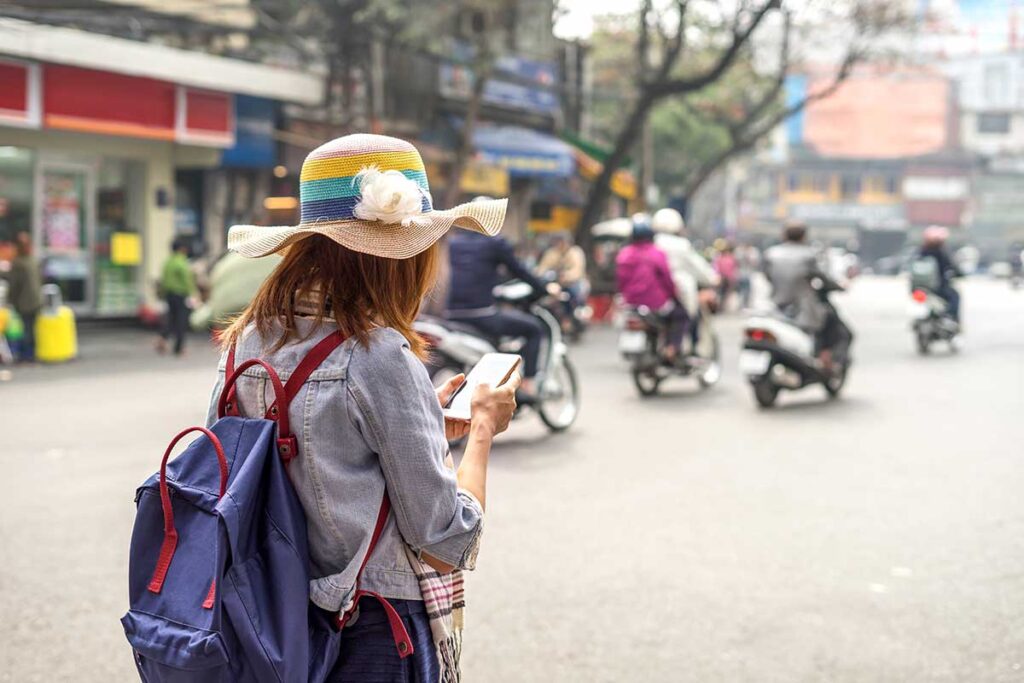
Wo du eine SIM-Karte kaufen kannst
Eine SIM-Karte kannst du direkt bei deiner Ankunft am Flughafen oder in zahlreichen Handyshops in größeren Städten wie Hanoi, Ho Chi Minh Stadt oder Da Nang kaufen. Der Prozess ist schnell, und das Personal hilft dir in der Regel beim Einrichten der SIM-Karte in deinem Handy.
Tarife und Preise
In Vietnam gibt es mehrere Mobilfunkanbieter, darunter Viettel, MobiFone und Vinaphone. Die Preise für Datenpakete sind sehr günstig – für etwa 5-10 USD bekommst du bereits eine SIM-Karte mit ausreichend Datenvolumen. Du kannst zwischen Prepaid- und Postpaid-Optionen wählen, wobei die meisten Reisenden Prepaid bevorzugen.
Hier findest du unseren vollständigen Leitfaden zum Kauf einer vietnamesischen SIM-Karte.
Geheimtipp: Viettel ist der beste Anbieter für Netzabdeckung in Vietnam. Sie bieten einen großartigen landesweiten Service und sogar eSIMs, was für Reisende mit eSIM-kompatiblen Handys eine bequeme Option ist.
Geheimtipp: Reisende, die bei uns von Local Vietnam buchen, erhalten bei der Ankunft eine kostenlose SIM-Karte, sodass du während deiner gesamten Reise mit uns verbunden bleiben kannst – für einfache Kommunikation und Unterstützung.

16. Nutze die Wäschereien
Einer der besten Reisetipps für Vietnam ist es, die örtlichen Wäschereien zu nutzen. Wäschewaschen ist in Vietnam unglaublich günstig, und es ist eine einfache Möglichkeit, leicht zu reisen, ohne zu viele Klamotten einpacken zu müssen.
Wo du Wäschereien findest
Wäschereien sind in Städten und Touristengebieten weit verbreitet. Egal, ob du in einem Hotel, Gästehaus oder Homestay übernachtest – viele Unterkünfte bieten einen Wäscheservice an. Alternativ findest du in größeren Städten wie Hanoi oder Ho Chi Minh Stadt an fast jeder Straße lokale Wäschereien.
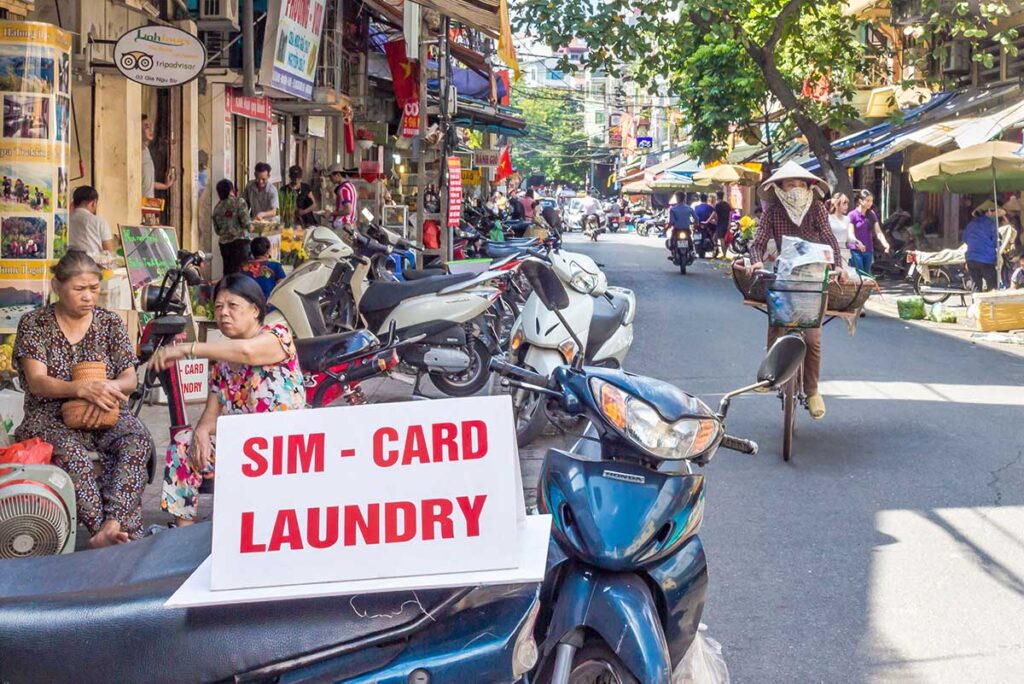
Preise und Komfort
Wäschewaschen ist günstig – die Preise liegen oft bei etwa 1 EUR pro Kilo. Der Service ist schnell – die meisten Wäschereien waschen und falten deine Kleidung innerhalb von 24 Stunden, und in einigen Gegenden gibt es sogar Express-Services, falls du es eilig hast. Wenn du Zeit sparen möchtest, bieten viele Orte auch Abhol- und Lieferservices direkt von deiner Unterkunft an.
17. Bargeld ist in Vietnam unverzichtbar
Auch wenn Kreditkarten in Vietnam immer häufiger akzeptiert werden, ist Bargeld immer noch die bevorzugte Zahlungsmethode, besonders in kleinen Geschäften, auf Märkten und in ländlichen Gebieten. Es ist wichtig, immer genügend Bargeld für alltägliche Ausgaben bei sich zu haben.
Geldautomaten und Währungsumtausch
Geldautomaten sind in großen Städten wie Hanoi und Ho Chi Minh Stadt leicht zu finden, wo du Vietnamesische Dong (VND) abheben kannst. Auch der Währungsumtausch ist einfach in Banken oder Wechselstuben, allerdings können die Kurse variieren, daher lohnt es sich, die Optionen zu vergleichen.
Geheimtipp: Goldgeschäfte in Hanoi und Ho Chi Minh Stadt bieten oft überraschend gute Wechselkurse. Sie können eine bessere Option zum Geldwechseln sein als Banken oder Wechselstuben.
Bargeld für kleine Ausgaben
Für kleinere Einkäufe, besonders beim Kauf von Streetfood oder Souvenirs auf lokalen Märkten, solltest du immer bar bezahlen. Viele Verkäufer in ländlichen Gebieten akzeptieren keine Karten, daher ist es unerlässlich, Bargeld dabei zu haben. Achte darauf, kleinere Scheine mitzuführen, um das Bezahlen zu erleichtern.
Geheimtipp: Mach dich mit dem Geld vertraut! Der 500.000 VND-Schein und der 20.000 VND-Schein sehen sehr ähnlich aus, also sei vorsichtig, wenn du bezahlst.
18. Kaffeehäuser für eine Toilettenpause nutzen
Ein praktischer Reisetipp für Vietnam: Kaffeehäuser sind deine Rettung, wenn du eine Toilettenpause brauchst. Öffentliche Toiletten sind oft schwer zu finden oder nicht sehr sauber, aber Kaffeehäuser gibt es überall, und die meisten lassen dich die Toilette benutzen, wenn du ein Getränk kaufst.
Wie du Kaffeehäuser für eine Pause nutzen kannst
Kaffeehäuser sind zahlreich, besonders in Touristengebieten. Sie bieten günstige Getränke wie Kaffee, Tee und frische Säfte ab etwa 0,50 EUR an. Im Gegenzug für den Kauf eines Getränks darfst du in der Regel ohne Probleme die Toilette benutzen. Es ist eine einfache Lösung, wenn du unterwegs bist und schnell eine Pause brauchst.
Geheimtipp: Wenn du keine Lust auf ein Getränk hast, bestelle einfach einen Kaffee zum Mitnehmen. Das Personal wird dir trotzdem erlauben, die Toilette zu benutzen, und es ist ein kleiner Preis für eine saubere Toilette mitten im Trubel.
19. Mit Taxi-Apps durch die Stadt kommen
Taxi-Apps sind eine bequeme und günstige Möglichkeit, sich in Vietnam fortzubewegen, besonders in geschäftigen Städten wie Hanoi und Ho Chi Minh Stadt. Sie bieten eine sichere und zuverlässige Alternative zum Heranwinken eines traditionellen Taxis auf der Straße.
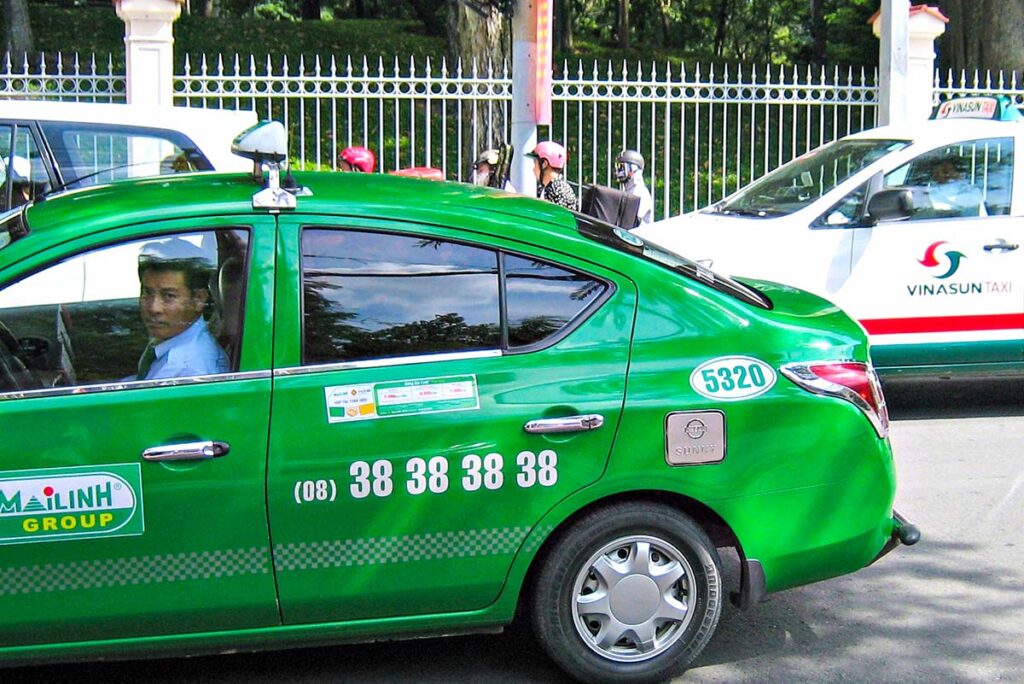
Wie man Taxi-Apps benutzt
Die beliebteste Taxi-App in Vietnam ist Grab, mit der du Taxis, Motorroller-Taxis und sogar Essenslieferungen direkt über dein Handy buchen kannst. Die Nutzung der App ist einfach:
- Lade die App herunter und installiere sie (verfügbar im App Store und bei Google Play).
- Richte dein Konto ein und füge deine Zahlungsmethode hinzu.
- Gib deinen Abhol- und Zielort ein und wähle deine bevorzugte Fahrt (Auto, Motorroller usw.).
- Bestätige die Buchung und warte auf die Ankunft deines Fahrers.
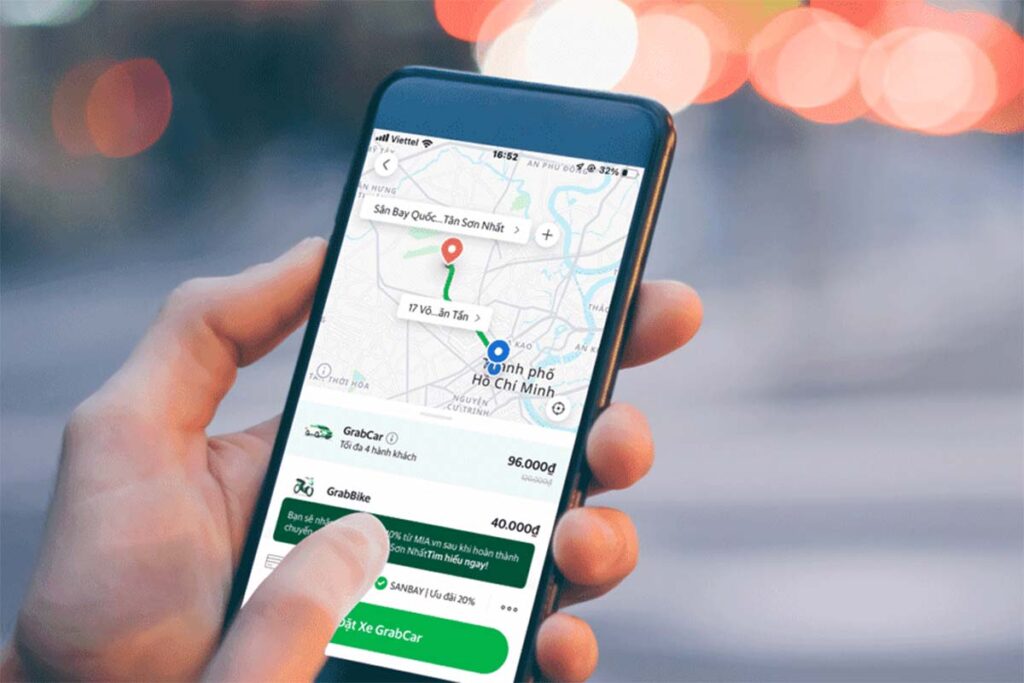
20. Das sind die besten Busse in Vietnam
Busse sind ein beliebtes und günstiges Transportmittel in Vietnam, besonders für längere Strecken zwischen Städten. Es gibt zwei Hauptarten von Bussen, die du finden wirst: Schlafbusse und Limousinenbusse. Hier ist, was du über beide Optionen wissen musst.
Schlafbusse:
Schlafbusse werden häufig für Langstreckenfahrten genutzt, besonders über Nacht. Sie bieten Liegesitze, die es dir ermöglichen, dich hinzulegen – eine bequeme Wahl für lange Reisen. Beliebte Strecken sind Ho Chi Minh Stadt nach Da Nang, Hanoi nach Sapa und Hanoi nach Ha Giang. Sie sind zwar erschwinglich, aber die Fahrten können ruckelig sein, und nicht jeder wird gut darin schlafen können.
Geheimtipp: Wenn du dich für einen Schlafbus entscheidest, buche nach Möglichkeit einen VIP-Schlafbus. Diese Busse bieten mehr Platz und Privatsphäre, was die Reise deutlich angenehmer macht. Der Aufpreis lohnt sich bei langen Fahrten.
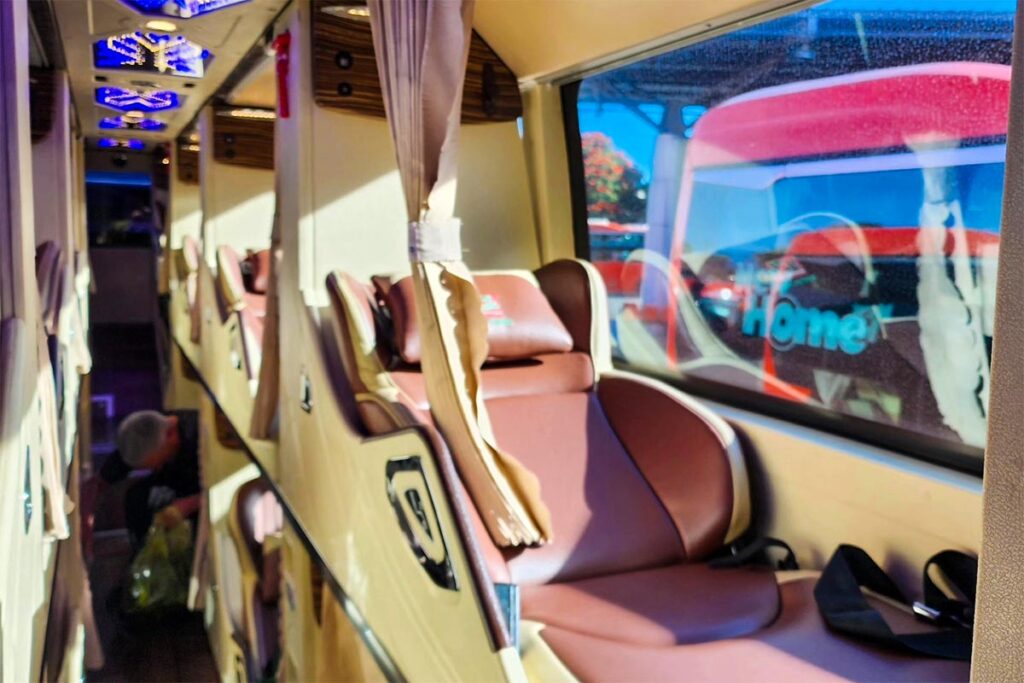
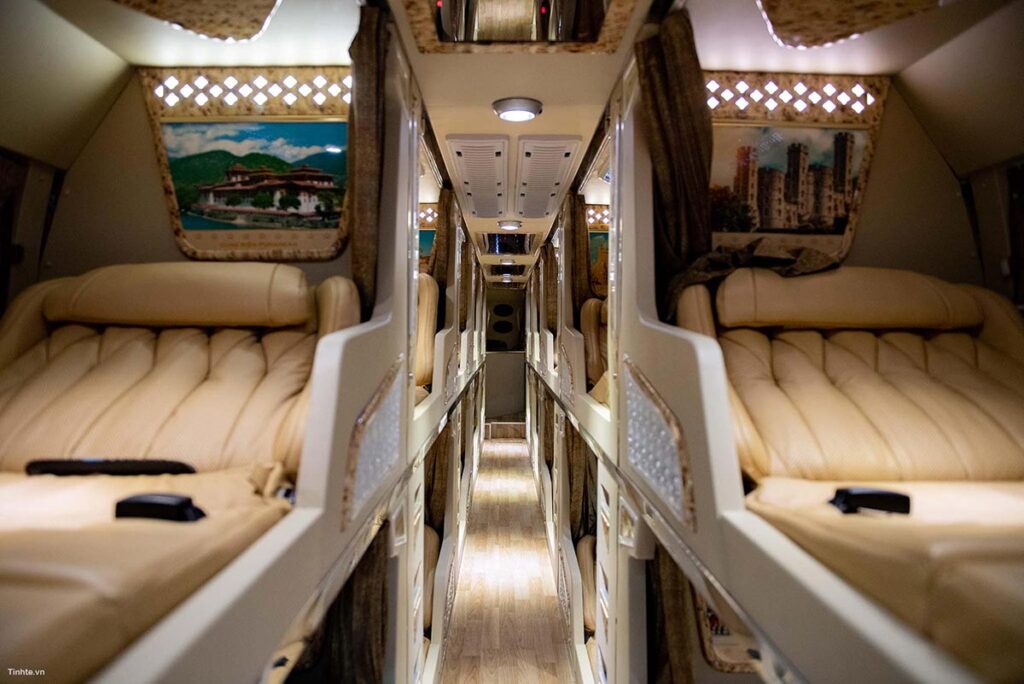
Limousinenbusse:
Limousinenbusse sind eine komfortablere Alternative zu normalen Bussen. Es handelt sich um geteilte Vans, die tagsüber verkehren und oft auf Strecken wie Ho Chi Minh Stadt nach Phan Thiet/Mui Ne oder Hanoi nach Ninh Binh genutzt werden. Sie fühlen sich auch oft sicherer an als Schlafbusse, besonders auf langen Fahrten.
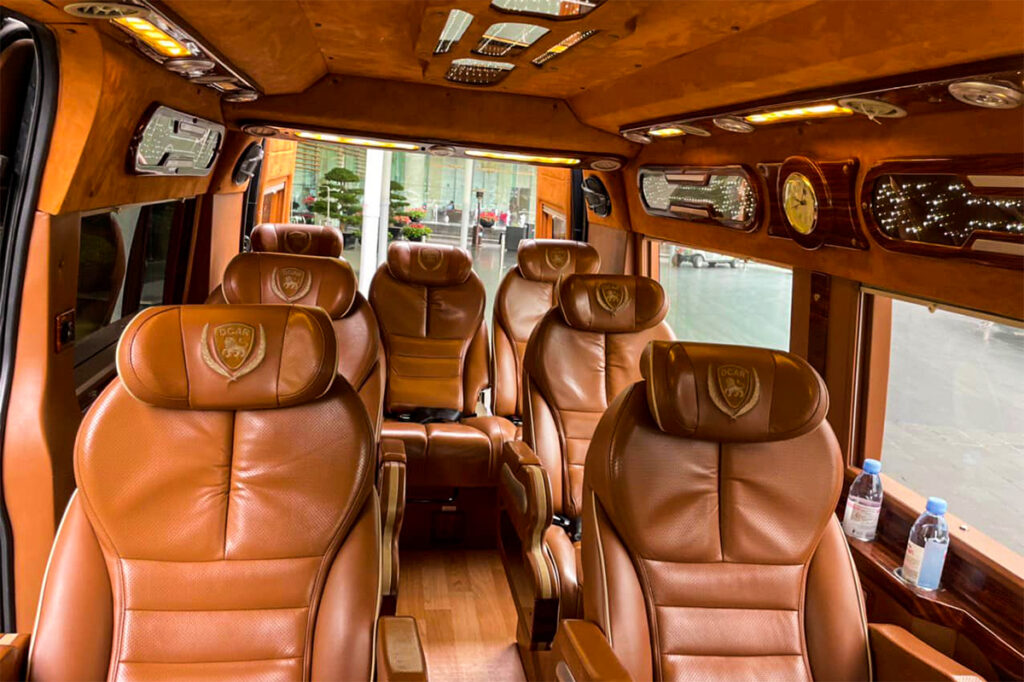
21. Tipps für Zugreisen in Vietnam
Zugfahren in Vietnam ist eine einzigartige und landschaftlich reizvolle Möglichkeit, das Land zu erkunden, besonders entlang der Küste. Zwar langsamer als Fliegen, bieten Züge eine komfortable und sichere Alternative sowie die Möglichkeit, die Landschaft zu genießen.
Wähle die richtige Klasse
Die Züge in Vietnam haben unterschiedliche Klassen, und die Qualität kann variieren. Für längere Fahrten empfiehlt es sich, eine 4-Bett-Schlafkabine zu buchen, die mehr Privatsphäre und Komfort bietet als die 6-Bett-Kabinen oder Sitzplatzoptionen. Die 4-Bett-Kabinen sind ruhiger und bieten mehr Platz für dein Gepäck.
Geheimtipp: Wenn du mit einer Begleitung reist, solltest du überlegen, alle vier Betten in der Kabine zu buchen, um Privatsphäre zu gewährleisten und nicht mit Fremden teilen zu müssen.
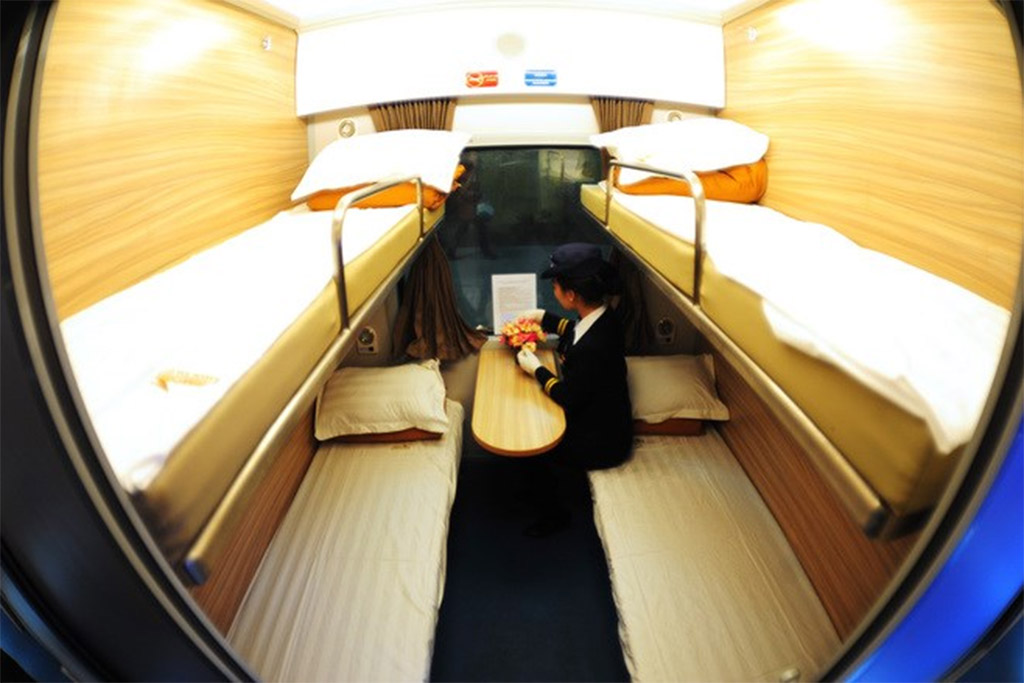
Buche Touristenzüge für mehr Komfort
Auf beliebten Strecken, wie Hanoi nach Sapa, gibt es Touristenzüge, die oft besser gepflegte Einrichtungen bieten, darunter bequemere Sitze und sauberere Kabinen. Diese Züge bieten oft zusätzliche Services wie Mahlzeiten oder bessere Klimaanlagen.
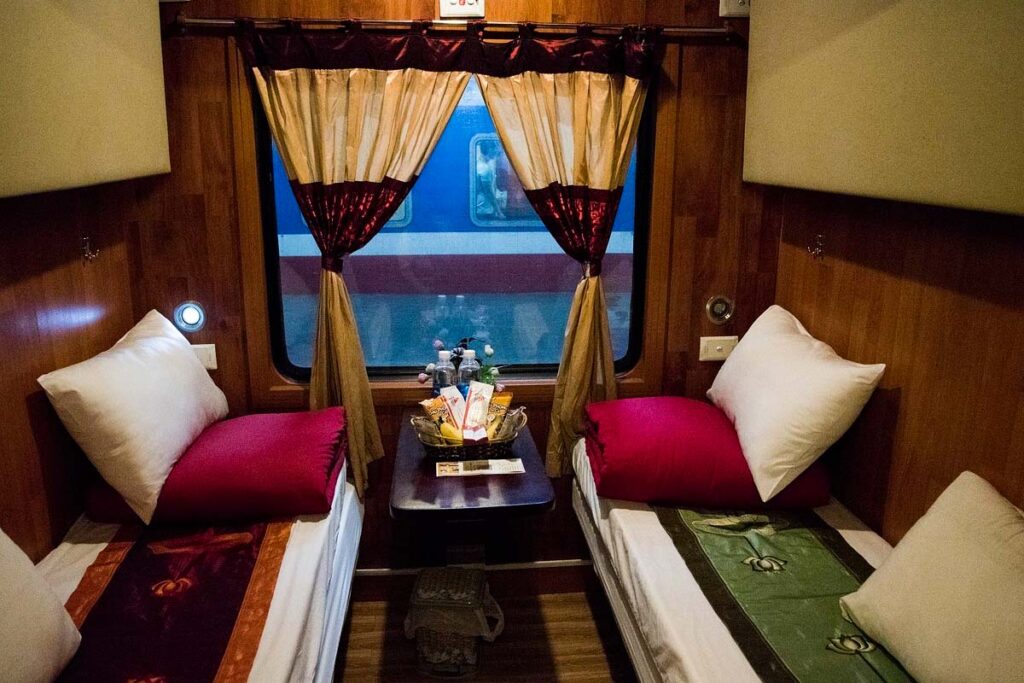
Was du mitbringen solltest
Für eine Zugreise solltest du Noise-Cancelling-Kopfhörer, Snacks und Hygieneartikel einpacken. Die Bordservices sind begrenzt, und eine lange Fahrt wird mit ein paar Extras angenehmer.
22. Vorsicht im Verkehr
Vietnam ist bekannt für seine relativ niedrige Kriminalitätsrate, aber das größte Risiko für Reisende ist oft der chaotische Verkehr. Ob zu Fuß, mit dem Fahrrad oder auf dem Motorroller – im Straßenverkehr musst du besonders vorsichtig sein.
Straßen überqueren
Das Überqueren der Straße kann einschüchternd sein, besonders in Städten wie Hanoi und Ho Chi Minh Stadt, wo unzählige Motorroller vorbeirasen. Der Schlüssel ist, ruhig zu bleiben, dich sichtbar zu machen und gleichmäßig zu gehen. Nicht anhalten oder rennen – der Verkehr wird um dich herumfahren, wenn du berechenbar bleibst. Das Wichtigste ist, weiterzugehen und die Fahrzeuge sich an dich anpassen zu lassen.
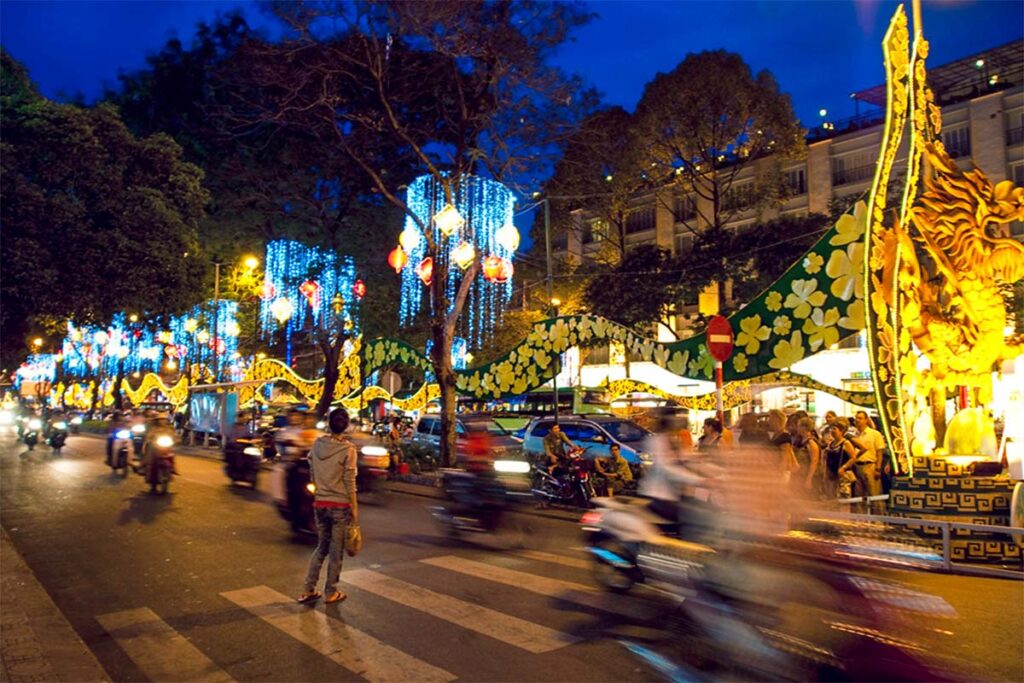
Mit dem Motorroller fahren
Motorroller sind das häufigste Fortbewegungsmittel in Vietnam, aber das Fahren kann gefährlich sein, besonders wenn du mit den örtlichen Verkehrsregeln und Bedingungen nicht vertraut bist. Wenn du dich auf dem Motorroller oder Scooter nicht wohlfühlst, sind Taxis, Ride-Hailing-Apps wie Grab oder sogar Motorroller-Taxis (xe ôm) die sicherere Wahl.
Geheimtipp: Wenn du dich entscheidest, einen Motorroller zu mieten, stelle sicher, dass du einen internationalen Führerschein (IDP) hast und eine Versicherung, die auch Unfälle mit dem Motorroller abdeckt.
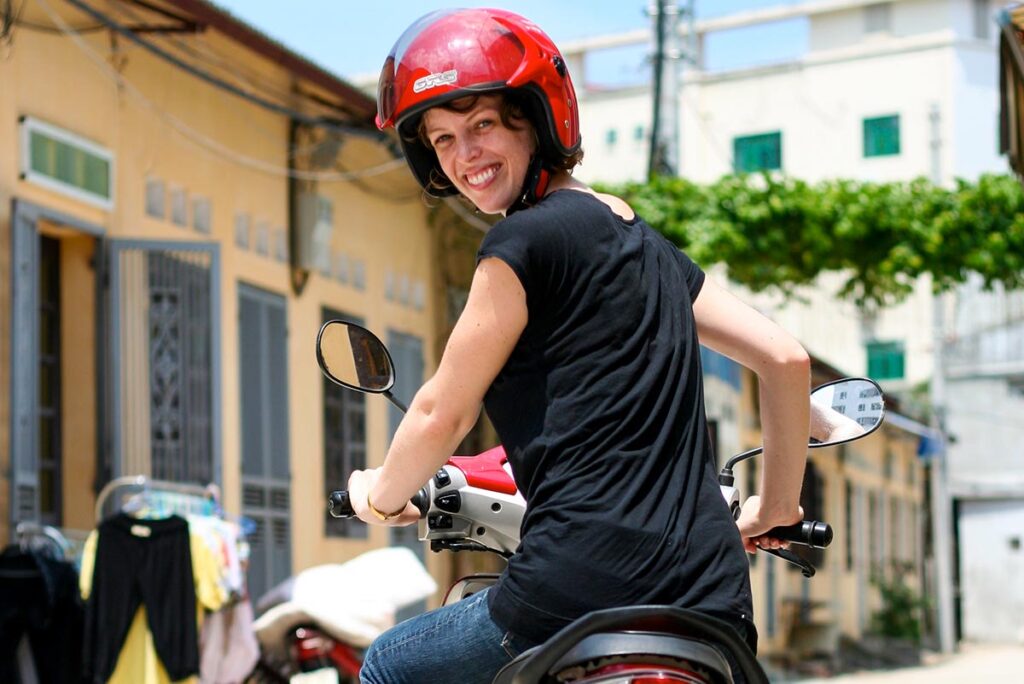
23. Probiere lokale Gerichte und wie du die besten Orte findest
Einer der besten Reisetipps für Vietnam ist, die lokale Küche zu genießen. Die vietnamesische Küche ist reichhaltig, vielfältig und köstlich – von Street Food bis zu raffinierten Gerichten. Es ist jedoch wichtig zu wissen, wie man die besten Orte für authentische und schmackhafte Mahlzeiten findet.
Bewertungen und Online-Empfehlungen prüfen
Wenn du nach Essensmöglichkeiten suchst, sind Apps wie TripAdvisor, Google Reviews und Foody.vn ausgezeichnete Ressourcen, um gut bewertete Restaurants und lokale Lokale zu finden. Lies dir die Bewertungen durch und schau dir Fotos an, um sicherzustellen, dass das Restaurant deinen Erwartungen an Qualität und Sauberkeit entspricht.
Achte auf Orte, an denen Einheimische essen
Eine der besten Möglichkeiten, gutes Essen zu finden, ist, darauf zu achten, wo die Einheimischen essen. Beliebte Street-Food-Stände und kleine Restaurants, die mit Einheimischen gefüllt sind, servieren in der Regel frische und geschmackvolle Gerichte. Wenn du eine Menschenmenge siehst, ist das ein gutes Zeichen für authentisches und leckeres Essen.
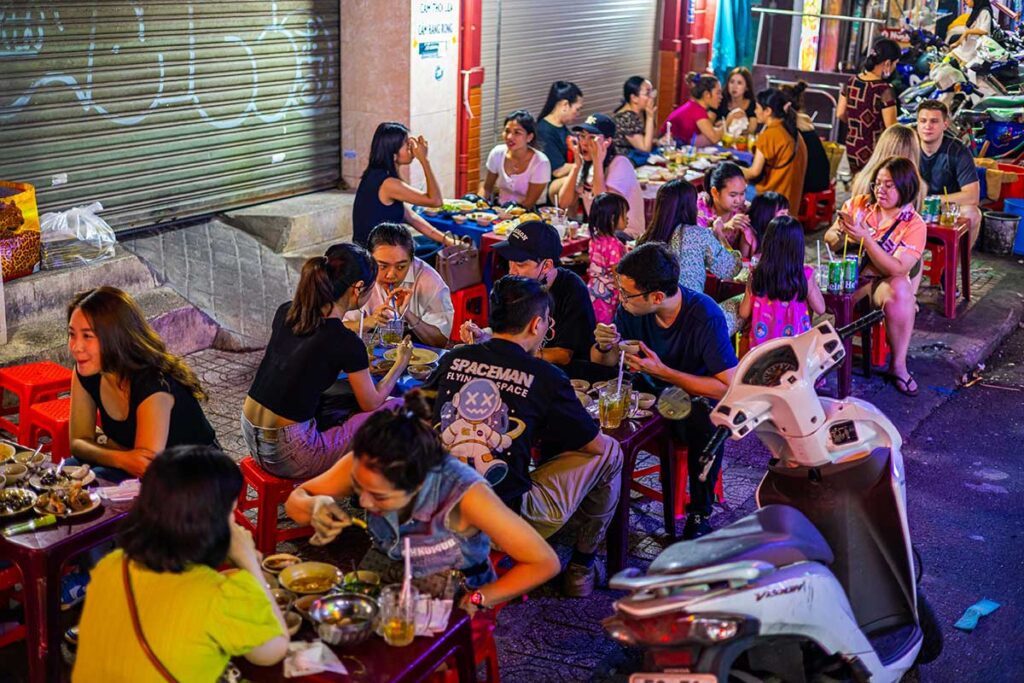
Mach eine Food-Tour mit
Wenn du ein geführtes Erlebnis bevorzugst, solltest du eine Food-Tour in Betracht ziehen. Lokale Guides zeigen dir einige der besten Lokale der Stadt und erklären die Geschichte und Bedeutung der einzelnen Gerichte. So kannst du eine Vielzahl an Speisen probieren und mehr über Vietnams kulinarische Kultur erfahren.
24. Kulturelle Do’s & Don’ts
Lokale Bräuche zu verstehen und zu respektieren, ist ein wichtiger Teil des Reisens in Vietnam. Mit diesen kulturellen Do’s und Don’ts kannst du ein angenehmeres und respektvolles Erlebnis haben, während du mit den Einheimischen interagierst.
Do: Begrüße mit einem Lächeln und einer leichten Verbeugung
In Vietnam ist ein freundliches Lächeln und eine leichte Verbeugung die beste Art, andere zu begrüßen. Die Vietnamesen sind herzlich und gastfreundlich, und eine respektvolle Geste hinterlässt einen positiven Eindruck.
Do: Kleide dich bescheiden, besonders in Tempeln und Pagoden
Beim Besuch religiöser oder heiliger Orte wie Tempeln, Pagoden oder ethnischen Dörfern ist es wichtig, sich angemessen zu kleiden. Bedecke deine Schultern und Knie, um den lokalen Traditionen Respekt zu erweisen.
Do: Ziehe deine Schuhe aus, wenn du Häuser und manche Geschäfte betrittst
Es ist üblich, die Schuhe auszuziehen, bevor man ein Haus, bestimmte Geschäfte oder Tempel betritt. Sei immer darauf vorbereitet, deine Schuhe auszuziehen, wenn du solche Orte betrittst. Oft findest du Schuhregale oder gekennzeichnete Bereiche in der Nähe des Eingangs.
Don’t: Fotografiere keine Menschen ohne Erlaubnis
Obwohl Vietnam voller schöner Orte und interessanter Menschen ist, solltest du um Erlaubnis fragen, bevor du Fotos von Einheimischen machst, besonders in ländlichen Gegenden oder Tempeln. Die meisten Menschen fühlen sich wohler, wenn du Landschaften oder öffentliche Orte fotografierst.
Don’t: Verliere nicht die Beherrschung in der Öffentlichkeit
In der Öffentlichkeit die Beherrschung zu verlieren, wird in Vietnam als sehr respektlos angesehen. Es ist wichtig, ruhig und gelassen zu bleiben, besonders bei kleineren Ärgernissen. Wutausbrüche in der Öffentlichkeit sind unangenehm und werden nicht gern gesehen.
Don’t: Zeige keine Zuneigung in der Öffentlichkeit
Während Händchenhalten oder Umarmen im Privaten üblich ist, sind öffentliche Zuneigungsbekundungen in Vietnam nicht gern gesehen. Vermeide Küssen, übermäßige Berührungen oder intime Gesten in der Öffentlichkeit, um die örtlichen Gepflogenheiten zu respektieren.

25. Spülen oder nicht spülen
Eine häufige Frage für Reisende in Vietnam ist, ob Toilettenpapier heruntergespült werden darf oder nicht. Das hängt stark davon ab, wo du dich aufhältst. Hier ist ein kurzer Leitfaden, um dich in den Badezimmern zurechtzufinden.
In älteren Gebäuden oder ländlichen Gebieten
In vielen älteren Gebäuden oder ländlichen Gebieten sind die Abwassersysteme möglicherweise nicht für Toilettenpapier ausgelegt. In solchen Fällen findest du oft einen kleinen Abfalleimer neben der Toilette, in dem das Toilettenpapier entsorgt werden sollte. Achte immer auf Schilder oder Anweisungen im Badezimmer, die dir zeigen, was zu tun ist.
In modernen Hotels und Resorts
In modernen Unterkünften, insbesondere in Hotels oder Resorts, ist das Herunterspülen von Toilettenpapier in der Regel unproblematisch. Wenn du dir unsicher bist, achte auf Schilder oder frage das Personal, um Unannehmlichkeiten zu vermeiden.
Persönliche Reisetipps für Vietnam
Während wir bereits viele allgemeine Reisetipps für Vietnam abgedeckt haben, gibt es je nach Reisestil oder persönlichen Umständen noch einige weitere Überlegungen. Für detaillierte Ratschläge zu bestimmten Themen sieh dir unsere anderen Artikel an:
- Reisen mit Kindern: Tipps und Empfehlungen, um deine Vietnamreise für die ganze Familie angenehm zu gestalten.
- Reisen mit Allergien: Wie du die vietnamesische Küche genießen und gleichzeitig deine Allergien im Griff behalten kannst.
- Reisen während der Regenzeit: Was dich erwartet und wie du dich auf die nasse Jahreszeit in Vietnam vorbereitest.
- Alleinreisen in Vietnam: Ratschläge für Alleinreisende, insbesondere Frauen, um sicher und unbeschwert zu reisen.
Wenn du noch persönlichere Tipps benötigst, tritt gerne unserer Facebook-Gruppe bei, in der unsere Community und Experten dir bei spezifischen Fragen weiterhelfen.
Unser bester Reisetipp für Vietnam
Eine Reise nach Vietnam zu planen, kann überwältigend sein, wenn es so viel zu organisieren und zu erleben gibt. Vom Auswählen der besten Reiseziele bis zum Buchen von Transportmitteln kann es schnell viel werden. Und genau hier kommen wir ins Spiel!
Lass uns dir helfen
Unser bester Reisetipp für Vietnam: Nutze Local Vietnam für eine stressfreie und maßgeschneiderte Reiseerfahrung. Unsere lokalen Experten stellen deine Reise nach deinen Wünschen zusammen – egal, ob du dich auf kulturelle Sehenswürdigkeiten, Abenteueraktivitäten oder versteckte Juwelen abseits der üblichen Pfade konzentrieren möchtest. Wir kümmern uns um alle Details, von Unterkünften bis zum Transport, damit du dich voll und ganz auf dein Erlebnis konzentrieren kannst.
Tipp: Fordere einen kostenlosen Reiseplan bei uns an, und wir senden dir innerhalb von 1–2 Tagen eine personalisierte Reiseroute. Du kannst sie so lange anpassen, bis sie perfekt für dich ist.